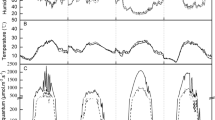Summary and conclusion
One of the common causes of the death of the lower leaves in the tropics is a deficiency in light energy. The death of leaves from light deficiency results from the weakening of the leaves as a result of a decrease in their photosynthetic capacity, poor retention of nutrients, and decomposition of proteins which results in ammonia accumulation.
Rice yields decrease under mutually shaded conditions. The removal of the lower leaves is less harmful than shading them. This indicates that their death under mutually shaded conditions may be advantageous. It is obvious, however, that the use of genetic materials or cultural practices which would allow the lower leaves to function normally until the plant approaches maturity would be highly desirable. Such materials and procedures would clearly involve reduced leafiness and the harmful effects of mutual shading.
Similar content being viewed by others
Literature cited
Araki, K., Studies on relationship between functioning of lower leaf blades and yield of paddy rice plant in the warm area of Japan (Part 3) Influence of excision of lower leaf blades after booting stage upon roots and comparison between the above excision and excision of individual upper leaf blades after flowering stage. J. Sci. Soil and Manure, Japan33 13–16 (1962).
Ishizuka, I. and Tanaka, A., Studies on ecological characteristics of rice plants grown in different localities, especially from standpoint of the nutrio-physiological character of the plants (Part 4). Studies on the physiological relation between drying of the lower leaves and the grain-straw ratio. J. Sci. Soil and Manure, Japan27 145–148 (1956).
Jennings, P. R., Plant types as a rice breeding objective. Crop Sci4 13–15 (1964).
Murata, Y., Studies on the photosynthesis of rice plants and its culture significance. Bull. Nat. Agr. Sci. (Japan)D9 1–169 (1961).
Tanaka, A., Studies on the nutrio-physiology of the leaves of the rice plant. J. Fac. Agr. Hokkaido Univ.51 450–550 (1961).
Tanaka, A. and Navasero, S. A., Loss of nitrogen from the rice plant through rain or dew. Soil Sci. and Plant Nutrition10 36–39 (1964).
Tanaka, A., Navasero, S. A., Garcia, C. V., Parao, F. T., and Ramirez. E., Growth habit of the rice plant in the tropics and its effect on nitrogen response. IRRI Technical Bulletin 3 (1964).
Tanaka, A. and Kawano, K., Effec tof mutual shading on dry matter production in. the rice plant. Plant and Soil. (In press).
Tanaka, A., Mutual shading as a factor limiting the yield response of rice to application of nitrogen, phosphorus and potassium fertilizers. Plant ans Soil. (In press).
Author information
Authors and Affiliations
Additional information
A portion of the master's thesis of S. A. Navasero submitted to the Graduate School, University of the Philippines.
Rights and permissions
About this article
Cite this article
Navasero, S.A., Tanaka, A. Low-light-induced death of lower leaves of rice and its effect on grain yield. Plant Soil 25, 17–31 (1966). https://doi.org/10.1007/BF01347958
Received:
Issue Date:
DOI: https://doi.org/10.1007/BF01347958




